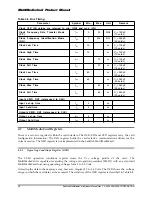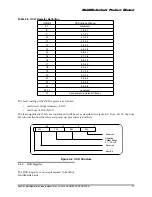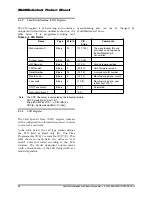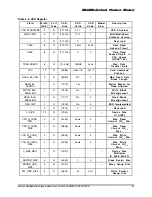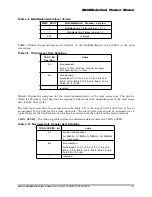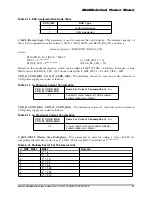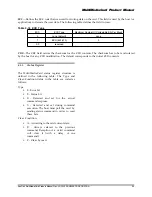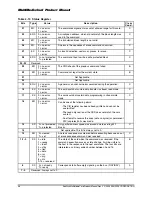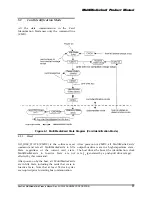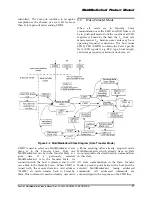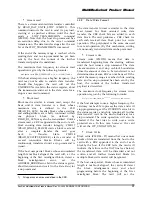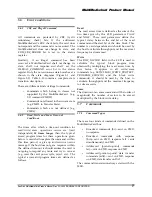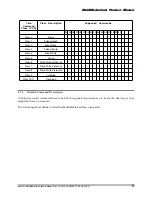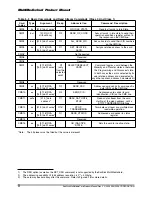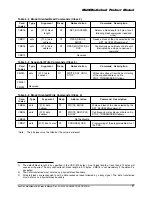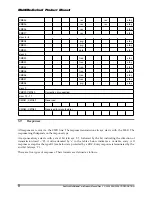
MultiMediaCard Product Manual
SanDisk MultiMediaCard Product Manual Rev. 2 © 2000 SANDISK CORPORATION
40
5.2.2
Operating Voltage Range Validation
The MultiMediaCard standard requires that a l l
MultiMediaCards will be able to establish
communication with the host using any operating
voltage between V
DD
-min and
V
DD
-max. However,
during data transfer minimum and maximum
values for
V
DD
are defined in the card specific
data register (CSD) and may not cover the whole
range. MultiMediaCard hosts are expected to read
the card’s CSD register and select proper
V
D D
values or reject the card.
MultiMediaCards that store the CID and CSD
data in the payload memory can communicate this
information only under
data-transfer V
D D
conditions. This means if host and card have non
compatible
V
DD
ranges, the card will not be able to
complete the identification cycle, nor to send CSD
data.
SEND_OP_COND (CMD1) is designed to provide
MultiMediaCard hosts with a mechanism to
identify and reject cards which do not match the
host’s desired V
DD
range. This is accomplished by
the host sending the required
V
DD
voltage window
as the operand of this
command.
MultiMediaCards which can not perform data
transfer in the specified range must discard
themselves from further bus operations and go into
Inactive State. All other MultiMediaCards will
respond concurrently (same method as card
identification) sending back their
V
DD
range. The
wired-or result of the response will show a l l
voltage ranges which some of the cards do not
support.
By omitting the voltage range in the command,
the host can query the MultiMediaCard stack and
determine if there are any non compatibilities
before sending out-of-range cards into the Inactive
State. Bus query should be used if the host can
select a common voltage range or wants to notify
the application of non usable cards in the stack.
The busy bit in the CMD1 response can be used by a
card to tell the host that it is still working on its
power-up/reset procedure (e.g. downloading the
register information from memory field) and is not
ready yet for communication. In this case the host
must repeat CMD1 until the busy bit is cleared.
During the initialization procedure, the host is
not allowed to change the OCR values. Changes in
the OCR content will be ignored by the
MultiMediaCard. If there is a real change in the
operating conditions the host must reset the card
stack (using CMD0) and begin the initialization
procedure once more.
GO_INACTIVE_STATE (CMD15) can also be used
to send an addressed MultiMediaCard into the
Inactive State. This command is used when the
host explicitly wants to deactivate a card (e.g.
host is changing V
DD
into a range which is known
to be not supported by this card).
5.2.3
Card Identification Process
The host starts the card identification process in
open-drain mode with the identification clock
rate f
OD
. The open drain driver stages on the CMD
line allow parallel card operation during card
identification.
After the bus is activated and a valid operation
condition is obtained, the host then asks all cards
for their unique card identification (CID) number
with the broadcast command ALL_SEND_CID
(CMD2). All remaining unidentified cards (i.e.
those which are in Ready State) simultaneously
start sending their CID numbers serially, while
bit-wise monitoring their outgoing bit stream.
Those cards, whose outgoing CID bits do not match
the corresponding bits on the command line in any
one of the bit periods, stop sending their CID
immediately and must wait for the next
identification cycle (cards stay in the Ready
State). Since CID numbers are unique for each
MultiMediaCard, there should be only one card
which successfully sends its full CID-number to
the host. This card then goes into Identification
State.
The host issues
CMD3,
(SET_RELATIVE_ADDR) to assign this card a
relative address (RCA), which is shorter than
CID and which will be used to address the card in
future
data transfer mode
communication
(typically with a higher clock rate than f
OD
).
Once the RCA is received the card transfers to the
Stand-by State and does not react to further
identification cycles. The MultiMediaCard also
switches its output drivers from open-drain to
push-pull.
The host repeats the identification process as long
as it receives a response (CID) to its identification
command (CMD2). When no MultiMediaCard
responds to this command, all cards have been

